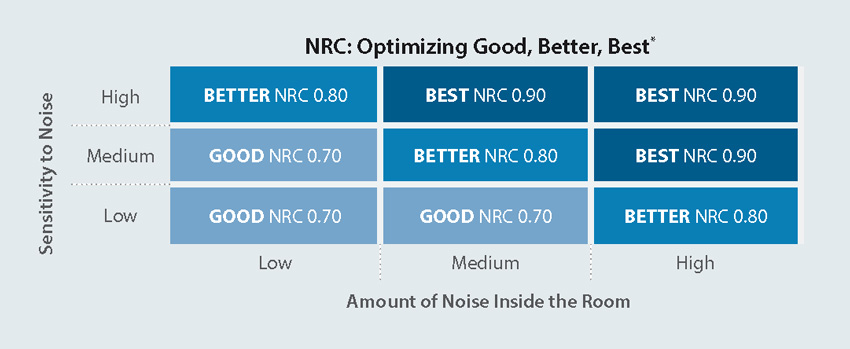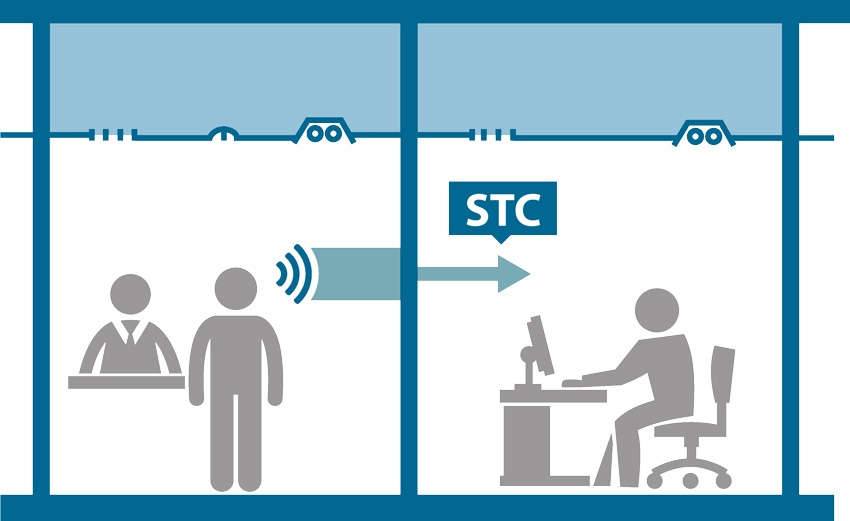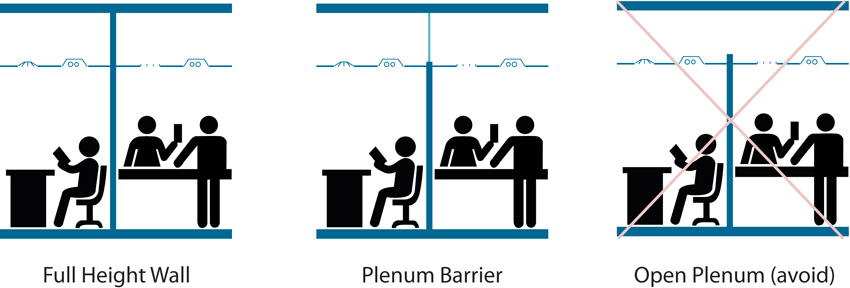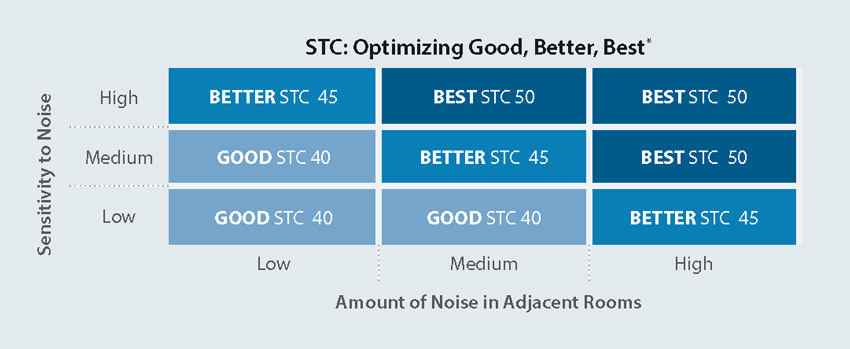Optimizing Acoustics for Effective Sound Design and Performance
If, you’re not working with an acoustics consultant or for some reason your project doesn’t need to comply with a building code or standard, you’ll have to figure out what NRC you want to use. The following Optimizing Absorption matrix can lead a designer toward the right absorption performance (NRC) for his or her project:

*Values are based on the requirements of current acoustics standards, guidelines, and rating systems.
How to use the matrix: Simply rate the user’s sensitivity to noise as low, medium, or high, and then rate the potential for noise in the space as low, medium, or high. The matrix will then give you the NRC for the ceiling. The matrix values are based on today’s acoustic standards. As an example, we can use an emergency room department admitting and triage area. In that kind of space, there’s a lot of potential for noise and a high sensitivity to noise (ex: a missed clinical instruction or direction for medication could be life threatening). With a high sensitivity to noise and high potential for noise, the matrix leads to an NRC of 0.90 or higher for the ceiling in this application.
Optimizing Blocking
Now that we’ve optimized our absorption, we next have to decide where—and if—blocking is important for a specific project. If it is important, the question to ask is “which” sound-blocking design approach do we want to use?
What is blocking? Blocking is preventing sound in one room from entering the room next to it. It’s different than absorption, which is controlling the sound generated inside the space you are in. Blocking is only important where you need privacy between two adjacent rooms.
Determining if blocking is needed. There are, in fact, many spaces where blocking is not required, such as in places where medium to large groups of people are in open spaces—open offices, airport concourses, restaurants, malls, retail stores, lobbies, atriums, waiting areas, gymnasiums, cafeterias, etc. As a caveat, it should be noted, though, that blocking may still be a factor for smaller rooms that abut these areas. When blocking is not relevant, optimizing sound absorption is the only important step.
Criteria in the standards: STC. When dealing with blocking, you mostly see sound transmission class (STC) in the standards. As previously discussed, STC is the most common blocking criterion overall. It applies to the noise-blocking capacity of the wall construction between rooms and to other assemblies as well. The building codes, standards, guidelines, and rating systems require sound blocking to be accomplished with full-height walls (from the slab to the slab above or the roof) and assumes all the penetrations, if any, are sealed.
Blocking can be categorized as best (STC 50 or higher), better (STC 45 or higher), or good (STC 40 or higher). You should avoid STC below 40 as it does not provide adequate sound privacy.

Sound transmission class (STC) is the most common blocking criterion in standards and guidelines. Ratings of 45 and 50 are common.
Design approach options. If you have determined that blocking is important between two adjacent spaces, there are a couple of options to choose from.
Best option: Extend the demising walls full height up to the slab or roof above. This is the approach required by most standards and guidelines and leads to the highest level of blocking and achieving STC 45, 50+. As an added benefit, the noise leaks or flanking paths through the ceilings are mostly inconsequential, and you don’t have to remediate them.
Better/Good option: Use a plenum barrier or partial wall, which will allow you to achieve STC 40, 45 or 50. With this option, ceiling flanking paths may need to be remediated.
Note: Using ceiling systems alone to block noise is ineffective.
Full-height walls vs. plenum barriers. By full-height walls, we mean extending all of the lower wall construction up past the ceiling level so that it completely blocks off the plenum and seals up against the floor or roof above. This approach is typically mandated by the standards and guidelines. Any time you see a STC requirement, you know the wall is supposed to be full height and any penetrations through it sealed airtight. While this approach is best, it can be difficult to do in existing buildings that already have walls that stop at the ceiling level.
At times, in new construction, full-height walls can be overdesigned and unnecessarily costly when a suspended, modular, acoustics ceiling is also used. There is some sound-blocking value provided by the ceiling. When you combine that with the sound-blocking capacity of the upper wall, the total is far greater than what’s being provided by the lower part of the wall alone. So the upper part of the wall—above the ceiling—does not always have to be the same construction as the lower part of the wall. Ideally, the blocking capacity up through the ceiling, through the upper wall, and down through the ceiling of the adjacent room is the same as that of the lower wall alone. That means the upper part of the wall can be simpler and lighter weight. These lightweight upper walls are called plenum barriers and can be far less costly than full-height walls.

Both full-height walls and lightweight plenum barriers can provide effective sound blocking between rooms. Modular, acoustic ceilings cannot.
Recent research shows that even when the wall between two rooms stops at the height of the suspended acoustic ceiling, STC 40, 45, and 50 levels of isolation can be achieved by adding a plenum barrier that begins at the top of the wall and extends up to the underside of the floor or roof above. The plenum barrier can be made of one or two layers of 1.5-inch-thick, lightweight, stone wool insulation with a foil facing on one side. Other materials are possible as well. The studs from the lower wall do not need to extend past the ceiling level. In fact, the ceiling grid can run continuously over the tops of the walls, making any future relocation of walls in response to organizational changes non-impactful on the ceiling and associated building systems. This is a particularly useful design approach above premanufactured, demountable partition systems that have become quite popular in contemporary buildings.
Plenum barriers can be mechanically fastened with several screws into a standard metal channel across the topside and friction fitted against the top of the wall along the bottom. The sides are abutted and covered with metal foil tape. A single-layer plenum barrier is typically used over walls that have standard doors and windows in them. Since these elements are typically the weak links in sound isolation, a more robust double-layer plenum barrier above the wall may not be needed. A single-layer plenum barrier in combination with a stone wool suspended acoustic ceiling system performs at STC 40 and should be used over walls with STC 35–40 ratings.
A double-layer plenum barrier is typically used over walls that don’t have doors or windows, such as walls separating two offices, classrooms, or patient rooms. These walls are typically rated at STC 45 or 50. The two layers of the plenum barrier are installed with a 1- to 2-inch-wide airspace between them to optimize the overall performance. See the figure below for further details. A double-layer plenum barrier in combination with a stone wool suspended acoustic ceiling system performs at STC 52 and should be used over walls with STC 45–50 ratings. Walls with ratings of STC 55 and above should be full height up the structure above and sealed airtight. This level of isolation is beyond the capabilities of plenum barriers.
Plenum barriers only need to be used between the two rooms that require privacy. They do not need to extend horizontally all the way around the perimeters of both rooms. This permits return air to still move freely in the plenum in unducted return air systems. If the plenum barriers do extend around the entire perimeter of the room, locate the penetrations for the supply duct, return duct, or opening and fire suppression system pipe over the door into the room. Any sound transmitting through the penetrations will still be lower in level than that transmitting through the door.
This example detail utilizes a stone wool plenum barrier to achieve high sound blocking (STC 45–50) as required by standards and guidelines without requiring full-height walls.
Similar to the NRC matrix for absorption, which we looked at earlier, designers may use the following Optimizing Blocking matrix when a standard or consultant is not providing the blocking performance requirement. This STC matrix can lead a designer toward the right blocking performance for his or her project when guidance is not otherwise given.

*Values are based on the requirements of current acoustics standards, guidelines, and rating systems.









